Weifeng Ge
Audio-VLA: Adding Contact Audio Perception to Vision-Language-Action Model for Robotic Manipulation
Nov 13, 2025Abstract:The Vision-Language-Action models (VLA) have achieved significant advances in robotic manipulation recently. However, vision-only VLA models create fundamental limitations, particularly in perceiving interactive and manipulation dynamic processes. This paper proposes Audio-VLA, a multimodal manipulation policy that leverages contact audio to perceive contact events and dynamic process feedback. Audio-VLA overcomes the vision-only constraints of VLA models. Additionally, this paper introduces the Task Completion Rate (TCR) metric to systematically evaluate dynamic operational processes. Audio-VLA employs pre-trained DINOv2 and SigLIP as visual encoders, AudioCLIP as the audio encoder, and Llama2 as the large language model backbone. We apply LoRA fine-tuning to these pre-trained modules to achieve robust cross-modal understanding of both visual and acoustic inputs. A multimodal projection layer aligns features from different modalities into the same feature space. Moreover RLBench and LIBERO simulation environments are enhanced by adding collision-based audio generation to provide realistic sound feedback during object interactions. Since current robotic manipulation evaluations focus on final outcomes rather than providing systematic assessment of dynamic operational processes, the proposed TCR metric measures how well robots perceive dynamic processes during manipulation, creating a more comprehensive evaluation metric. Extensive experiments on LIBERO, RLBench, and two real-world tasks demonstrate Audio-VLA's superior performance over vision-only comparative methods, while the TCR metric effectively quantifies dynamic process perception capabilities.
GaussianMorphing: Mesh-Guided 3D Gaussians for Semantic-Aware Object Morphing
Oct 02, 2025Abstract:We introduce GaussianMorphing, a novel framework for semantic-aware 3D shape and texture morphing from multi-view images. Previous approaches usually rely on point clouds or require pre-defined homeomorphic mappings for untextured data. Our method overcomes these limitations by leveraging mesh-guided 3D Gaussian Splatting (3DGS) for high-fidelity geometry and appearance modeling. The core of our framework is a unified deformation strategy that anchors 3DGaussians to reconstructed mesh patches, ensuring geometrically consistent transformations while preserving texture fidelity through topology-aware constraints. In parallel, our framework establishes unsupervised semantic correspondence by using the mesh topology as a geometric prior and maintains structural integrity via physically plausible point trajectories. This integrated approach preserves both local detail and global semantic coherence throughout the morphing process with out requiring labeled data. On our proposed TexMorph benchmark, GaussianMorphing substantially outperforms prior 2D/3D methods, reducing color consistency error ($\Delta E$) by 22.2% and EI by 26.2%. Project page: https://baiyunshu.github.io/GAUSSIANMORPHING.github.io/
GTAD: Global Temporal Aggregation Denoising Learning for 3D Semantic Occupancy Prediction
Jul 28, 2025Abstract:Accurately perceiving dynamic environments is a fundamental task for autonomous driving and robotic systems. Existing methods inadequately utilize temporal information, relying mainly on local temporal interactions between adjacent frames and failing to leverage global sequence information effectively. To address this limitation, we investigate how to effectively aggregate global temporal features from temporal sequences, aiming to achieve occupancy representations that efficiently utilize global temporal information from historical observations. For this purpose, we propose a global temporal aggregation denoising network named GTAD, introducing a global temporal information aggregation framework as a new paradigm for holistic 3D scene understanding. Our method employs an in-model latent denoising network to aggregate local temporal features from the current moment and global temporal features from historical sequences. This approach enables the effective perception of both fine-grained temporal information from adjacent frames and global temporal patterns from historical observations. As a result, it provides a more coherent and comprehensive understanding of the environment. Extensive experiments on the nuScenes and Occ3D-nuScenes benchmark and ablation studies demonstrate the superiority of our method.
Code2Logic: Game-Code-Driven Data Synthesis for Enhancing VLMs General Reasoning
May 20, 2025Abstract:Visual-language Chain-of-Thought (CoT) data resources are relatively scarce compared to text-only counterparts, limiting the improvement of reasoning capabilities in Vision Language Models (VLMs). However, high-quality vision-language reasoning data is expensive and labor-intensive to annotate. To address this issue, we leverage a promising resource: game code, which naturally contains logical structures and state transition processes. Therefore, we propose Code2Logic, a novel game-code-driven approach for multimodal reasoning data synthesis. Our approach leverages Large Language Models (LLMs) to adapt game code, enabling automatic acquisition of reasoning processes and results through code execution. Using the Code2Logic approach, we developed the GameQA dataset to train and evaluate VLMs. GameQA is cost-effective and scalable to produce, challenging for state-of-the-art models, and diverse with 30 games and 158 tasks. Surprisingly, despite training solely on game data, VLMs demonstrated out of domain generalization, specifically Qwen2.5-VL-7B improving performance by 2.33\% across 7 diverse vision-language benchmarks. Our code and dataset are available at https://github.com/tongjingqi/Code2Logic.
StreamBridge: Turning Your Offline Video Large Language Model into a Proactive Streaming Assistant
May 08, 2025Abstract:We present StreamBridge, a simple yet effective framework that seamlessly transforms offline Video-LLMs into streaming-capable models. It addresses two fundamental challenges in adapting existing models into online scenarios: (1) limited capability for multi-turn real-time understanding, and (2) lack of proactive response mechanisms. Specifically, StreamBridge incorporates (1) a memory buffer combined with a round-decayed compression strategy, supporting long-context multi-turn interactions, and (2) a decoupled, lightweight activation model that can be effortlessly integrated into existing Video-LLMs, enabling continuous proactive responses. To further support StreamBridge, we construct Stream-IT, a large-scale dataset tailored for streaming video understanding, featuring interleaved video-text sequences and diverse instruction formats. Extensive experiments show that StreamBridge significantly improves the streaming understanding capabilities of offline Video-LLMs across various tasks, outperforming even proprietary models such as GPT-4o and Gemini 1.5 Pro. Simultaneously, it achieves competitive or superior performance on standard video understanding benchmarks.
Enhancing Environmental Robustness in Few-shot Learning via Conditional Representation Learning
Feb 03, 2025
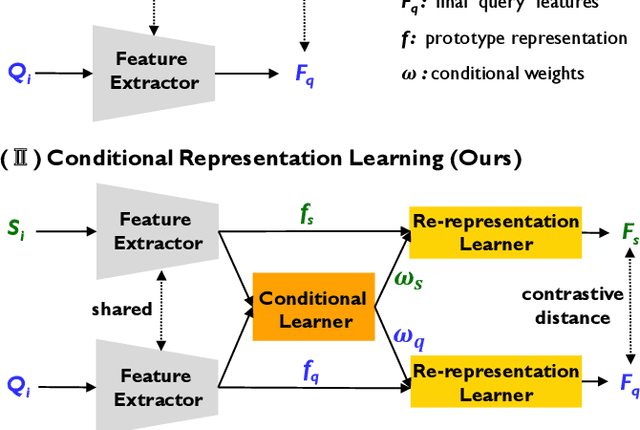

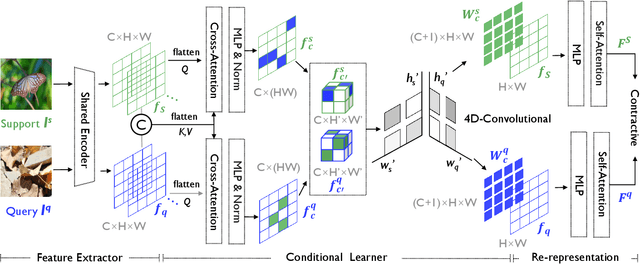
Abstract:Few-shot learning (FSL) has recently been extensively utilized to overcome the scarcity of training data in domain-specific visual recognition. In real-world scenarios, environmental factors such as complex backgrounds, varying lighting conditions, long-distance shooting, and moving targets often cause test images to exhibit numerous incomplete targets or noise disruptions. However, current research on evaluation datasets and methodologies has largely ignored the concept of "environmental robustness", which refers to maintaining consistent performance in complex and diverse physical environments. This neglect has led to a notable decline in the performance of FSL models during practical testing compared to their training performance. To bridge this gap, we introduce a new real-world multi-domain few-shot learning (RD-FSL) benchmark, which includes four domains and six evaluation datasets. The test images in this benchmark feature various challenging elements, such as camouflaged objects, small targets, and blurriness. Our evaluation experiments reveal that existing methods struggle to utilize training images effectively to generate accurate feature representations for challenging test images. To address this problem, we propose a novel conditional representation learning network (CRLNet) that integrates the interactions between training and testing images as conditional information in their respective representation processes. The main goal is to reduce intra-class variance or enhance inter-class variance at the feature representation level. Finally, comparative experiments reveal that CRLNet surpasses the current state-of-the-art methods, achieving performance improvements ranging from 6.83% to 16.98% across diverse settings and backbones. The source code and dataset are available at https://github.com/guoqianyu-alberta/Conditional-Representation-Learning.
DeTrack: In-model Latent Denoising Learning for Visual Object Tracking
Jan 05, 2025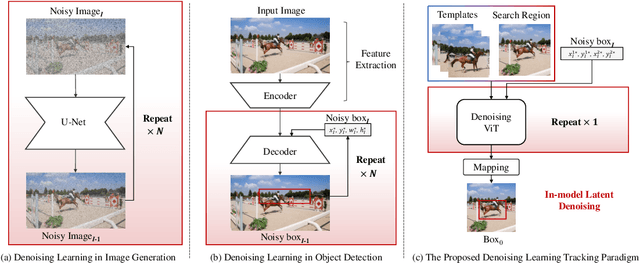

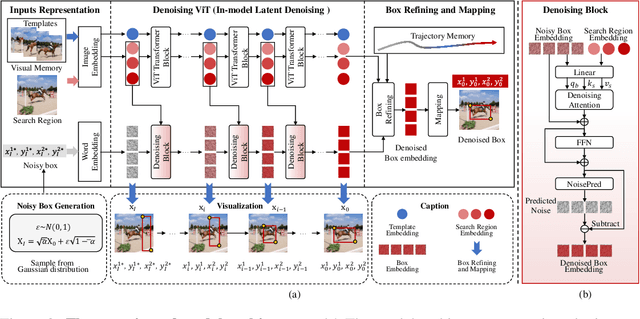
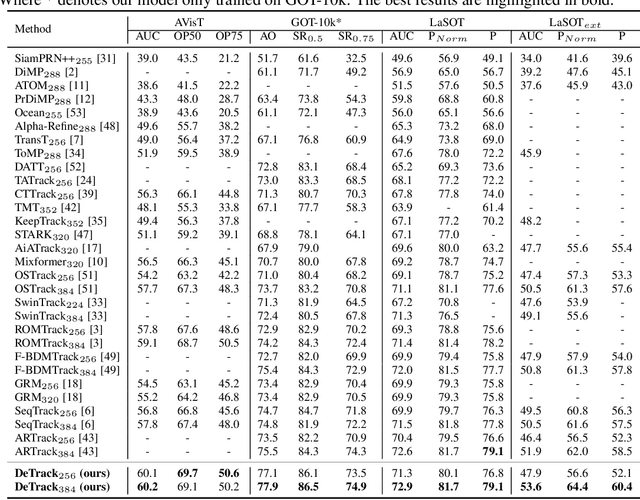
Abstract:Previous visual object tracking methods employ image-feature regression models or coordinate autoregression models for bounding box prediction. Image-feature regression methods heavily depend on matching results and do not utilize positional prior, while the autoregressive approach can only be trained using bounding boxes available in the training set, potentially resulting in suboptimal performance during testing with unseen data. Inspired by the diffusion model, denoising learning enhances the model's robustness to unseen data. Therefore, We introduce noise to bounding boxes, generating noisy boxes for training, thus enhancing model robustness on testing data. We propose a new paradigm to formulate the visual object tracking problem as a denoising learning process. However, tracking algorithms are usually asked to run in real-time, directly applying the diffusion model to object tracking would severely impair tracking speed. Therefore, we decompose the denoising learning process into every denoising block within a model, not by running the model multiple times, and thus we summarize the proposed paradigm as an in-model latent denoising learning process. Specifically, we propose a denoising Vision Transformer (ViT), which is composed of multiple denoising blocks. In the denoising block, template and search embeddings are projected into every denoising block as conditions. A denoising block is responsible for removing the noise in a predicted bounding box, and multiple stacked denoising blocks cooperate to accomplish the whole denoising process. Subsequently, we utilize image features and trajectory information to refine the denoised bounding box. Besides, we also utilize trajectory memory and visual memory to improve tracking stability. Experimental results validate the effectiveness of our approach, achieving competitive performance on several challenging datasets.
Compound-QA: A Benchmark for Evaluating LLMs on Compound Questions
Nov 15, 2024



Abstract:Large language models (LLMs) demonstrate remarkable performance across various tasks, prompting researchers to develop diverse evaluation benchmarks. However, existing benchmarks typically measure the ability of LLMs to respond to individual questions, neglecting the complex interactions in real-world applications. In this paper, we introduce Compound Question Synthesis (CQ-Syn) to create the Compound-QA benchmark, focusing on compound questions with multiple sub-questions. This benchmark is derived from existing QA datasets, annotated with proprietary LLMs and verified by humans for accuracy. It encompasses five categories: Factual-Statement, Cause-and-Effect, Hypothetical-Analysis, Comparison-and-Selection, and Evaluation-and-Suggestion. It evaluates the LLM capability in terms of three dimensions including understanding, reasoning, and knowledge. Our assessment of eight open-source LLMs using Compound-QA reveals distinct patterns in their responses to compound questions, which are significantly poorer than those to non-compound questions. Additionally, we investigate various methods to enhance LLMs performance on compound questions. The results indicate that these approaches significantly improve the models' comprehension and reasoning abilities on compound questions.
Grounded-VideoLLM: Sharpening Fine-grained Temporal Grounding in Video Large Language Models
Oct 04, 2024



Abstract:Video Large Language Models (Video-LLMs) have demonstrated remarkable capabilities in coarse-grained video understanding, however, they struggle with fine-grained temporal grounding. In this paper, we introduce Grounded-VideoLLM, a novel Video-LLM adept at perceiving and reasoning over specific video moments in a fine-grained manner. We identify that current Video-LLMs have limitations for fine-grained video understanding since they lack effective temporal modeling and timestamp representation. In light of this, we sharpen our model by incorporating (1) an additional temporal stream to encode the relationships between frames and (2) discrete temporal tokens enriched with specific time knowledge to represent timestamps. To optimize the training of Grounded-VideoLLM, we employ a multi-stage training scheme, beginning with simple video-captioning tasks and progressively introducing video temporal grounding tasks of increasing complexity. To further enhance Grounded-VideoLLM's temporal reasoning capability, we also curate a grounded VideoQA dataset by an automatic annotation pipeline. Extensive experiments demonstrate that Grounded-VideoLLM not only excels in fine-grained grounding tasks such as temporal sentence grounding, dense video captioning, and grounded VideoQA, but also shows great potential as a versatile video assistant for general video understanding.
Hierarchical Visual Categories Modeling: A Joint Representation Learning and Density Estimation Framework for Out-of-Distribution Detection
Aug 28, 2024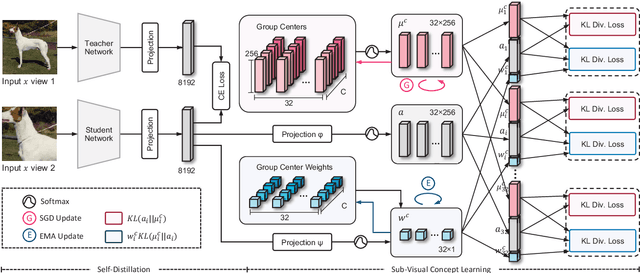

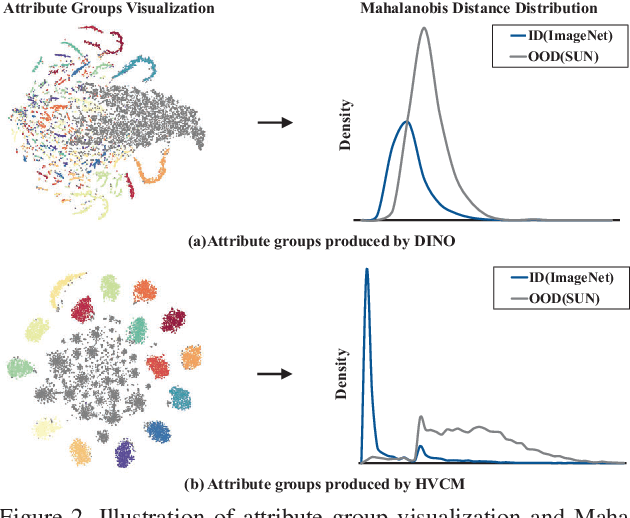
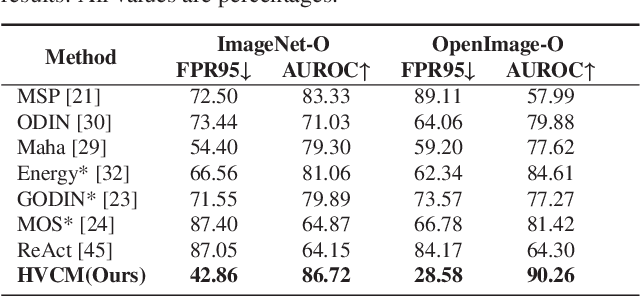
Abstract:Detecting out-of-distribution inputs for visual recognition models has become critical in safe deep learning. This paper proposes a novel hierarchical visual category modeling scheme to separate out-of-distribution data from in-distribution data through joint representation learning and statistical modeling. We learn a mixture of Gaussian models for each in-distribution category. There are many Gaussian mixture models to model different visual categories. With these Gaussian models, we design an in-distribution score function by aggregating multiple Mahalanobis-based metrics. We don't use any auxiliary outlier data as training samples, which may hurt the generalization ability of out-of-distribution detection algorithms. We split the ImageNet-1k dataset into ten folds randomly. We use one fold as the in-distribution dataset and the others as out-of-distribution datasets to evaluate the proposed method. We also conduct experiments on seven popular benchmarks, including CIFAR, iNaturalist, SUN, Places, Textures, ImageNet-O, and OpenImage-O. Extensive experiments indicate that the proposed method outperforms state-of-the-art algorithms clearly. Meanwhile, we find that our visual representation has a competitive performance when compared with features learned by classical methods. These results demonstrate that the proposed method hasn't weakened the discriminative ability of visual recognition models and keeps high efficiency in detecting out-of-distribution samples.
 Add to Chrome
Add to Chrome Add to Firefox
Add to Firefox Add to Edge
Add to Edge